Women in Woodworking
Meet Katie Jackson
by Andrea Ramsay
Seattle, WA
Click on any picture to see a larger version.
Editor's Note: We are happy to announce that Andrea Ramsay who was featured in this column in the
August 2015 issue of Wood News Online
has taken over interviewing and compiling this column from her friend, Anne Briggs Bohnett. We are excited to welcome Andrea to Wood News Online and we know she'll do a great job highlighting the amazing women in the world of woodworking!
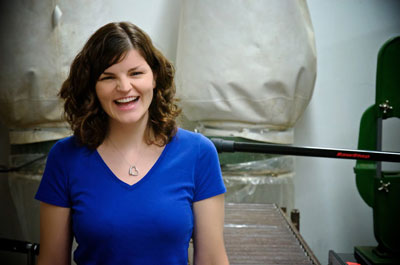
|
|
Photo by Patrick Tassos
|
When Anne Briggs Bohnett asked me to take over this column I said yes immediately. I knew I
would get to meet, either virtually or in person, inspiring and amazing people. This month I had
the opportunity to get to know Katie Jackson and hear her story. Katie is an inspiration, a doer,
active in building community, mentoring and teaching others. She is currently finishing a book,
HandBuilt Outdoor Furniture: 20 Projects Anyone Can Build
, to be released in April.
Katie was introduced to woodworking as a kid, building projects, such as a wooden gokart, with
her engineer Dad. Her Dad introduced her to 1994 AutoCAD and had her digitally model her
projects. She's still working on her computeraided drawing skills but prefers her planning
process to take place on postit notes. She studied visual arts and education at Bennington
College. During those summers, she worked for two years in the drama department of a girls'
camp, and became passionate about building sets. When the camp director asked her to head
the woodworking department, she wasn't entirely confident that she could take the safety of
children in a wood shop into her hands, so the camp director sent her to a course at a
foundation called Girls At Work. The course trained camp counselors to teach woodworking to
"atrisk" girls; it was about woodworking safety and technique, but its greater purpose was
empowering girls with skills and confidence. That concept really resonated with her, and she
loved teaching woodworking so much that she continued teaching for four years and went on to
study cabinetmaking at New England School of Architectural Woodworking.
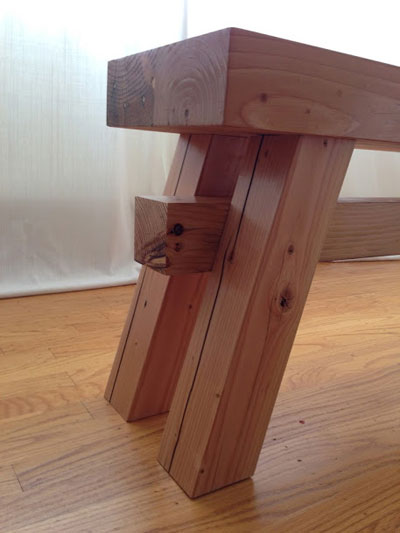
|
Trapezoid! Bench detail of the cracks and nail holes in the reclaimed wood.
Photo by Katie Jackson
|
After working in a few different wood shops, she moved out to the Bay Area and started building
custom furniture with a partner, Lilah CrewsPless. "There was such a wealth of salvaged
materials to be had that we built our pieces almost entirely out of reclaimed wood: my favorites
were giant old factory beams that we turned into tables and benches. We planed or sanded
down the outside surfaces just enough to reveal the beautiful wood within, but left the nail holes
and cracks to tell the wood's story." All of the furniture was flatpack as well, not because of any
grand design scheme, but simply because her car wouldn't have been able to haul around
anything larger. The two worked out of a wonderful makerspace called TechShop, both in San
Francisco and in Menlo Park (the latter has since moved its location to Redwood City). Lilah
decided to pursue other paths, and so "Lilah CrewsPless and Katie Jackson Woodworks"
became "Katie Jackson Woodworks." While Katie was attempting to determine the future of
Katie Jackson Woodworks, an editor from Timber Press asked her to author a projectbased
book on building outdoor furniture. She moved cross-country to Connecticut and became
involved with NESIT Hackerspace. This is where she built and photographed the twenty projects
for her book.
I asked Katie her thoughts on women in woodworking: "I consider myself fortunate to have been
educated in environments where one's work is judged based on skill, talent and ability rather
than on some arbitrary factor such as gender. Starting out in woodworking, I don't even
remember considering the fact that being a female woodworker was unusual. I certainly didn't
intend to be some kind of champion of women in woodworking, but as I started working in shops
where being a woman was unusual, I realized that, for better or for worse, my gender was a
factor in how I was perceived as person and as a craftsperson, and I now try to support other
women and girls who are interested in woodworking as much as I can. I am happy to say that
over my years of being a woodworker, I have noticed the numbers and reputation of women in
woodworking skyrocketing. There is still a ways to go until as many little girls get tool sets as little
boys do, but we are already well on that path." Her experience of running the woodshop at a girls'
camp cemented her love of teaching and mentoring. "My woodworkers were between 9 and 13
years old, and I got to work with them for the whole summer, which meant I was able to watch
them grow, over each summer and over the years, from being timid about even holding a
drill/driver to being insatiable for more and more time in the wood shop and creating beautiful
projects. Kids without fear are capable of amazing things, regardless of the expectations that
may have been previously set for their gender."
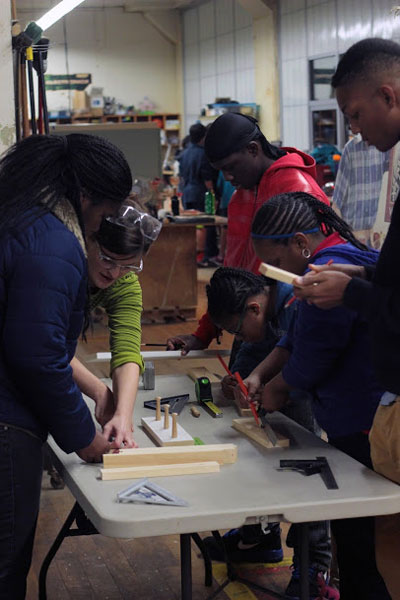
|
A workshop with the Newark, New Jersey Boys' and Girls' Club.
Photo by Andrew Peterson
|
Katie has this advice for those new to woodworking and really for us all: "Ask for help! I was
timid about asking for help as a teenager and I lost what could have been years of
projectmaking. I've found, however, that most people who love building are tickled pink to be
asked for advice about the thing they love to do...tool libraries, craft schools, makerspaces and
hackerspaces, and woodworking clubs are wonderful resources for a woodworker of any level of
experience. It's so important to support these institutions, so craft making continues through the
generations."
Katie is now member of a shared workshop space called NESIT Hackerspace. This year they
bought an Epilog laser cutter. She's learning about the intersection of woodworking and new
technology. "Fortunately for me, most of the people at NESIT know a lot more than me about
new technology (the IT in NESIT stands for information and technology) and are willing to help
me figure out vector graphics editing and computer aided design."
"Conversely, many of the people at the Hackerspace haven't learned much about woodworking.
I'm the 'Woodshop Czarina', and we've raised money over the last year to purchase a
SawStop Table Saw
, so I've been teaching a series of table saw classes. Being part of a workshop with
members of such a diverse range of knowledge means we all get to learn from one another."
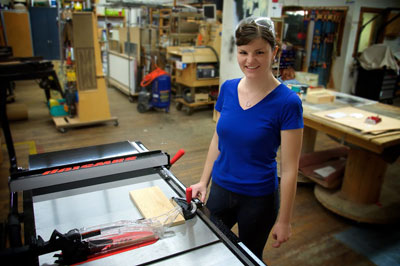
|
Katie in the woodshop.
Photo by Patrick Tassos
|
When I asked Katie what she enjoys most about woodworking, her answer is one we can all
relate to: "Between having a hundred things to do at once and being surrounded by glowing
screens demanding my attention wherever I go, it's a struggle to concentrate fully on any single
task. Working in the shop, though, is like a meditation. One hundred percent of my attention is
focused, and my brain is so happy to get the chance to function that way."
Look for Katie's book,
HandBuilt Outdoor Furniture: 20 Projects Anyone Can Build
, coming out
in April with Timber Press. She plans to be teaching classes in conjunction with the book's
release.
Katie can be found here:
KatieJacksonWoodworks.com
and here
Facebook.com/KatieJacksonWoodworks
.
Katie's Favorite Beginner Project
"For beginners, I love teaching them how to make the Shaker Pegboard Shelf project. It's a twopart project made out of
1" pine: the Shaker Pegboard part was the first project we made in our class for woodworking
teachers at Girls At Work, and adding the shelf and brackets can be optional (or even built
separately without the pegboard). This project introduces some basic power tools in an
appropriate order: first, a palm sander for the pegboard, which is loud (and therefore scary)
without having too much of a risk for injury." Katie explains that after a student gets comfortable
with the sander, they then learn measuring tricks, such as easily finding the center of a board.
The next step is the drill press and then to mallet the pegs in place. Quickly you will have a
finished project, and with that instant gratification comes confidence. If you choose, you can go
on to build the brackets, cut the shelf piece to length on a miter saw, and attach it all together,
learning how to counterbore holes for screws and filling the holes with flush cut plugs. This
project is a favorite choice of Katie's students even in upper level classes, and it is now the first
project in her book.
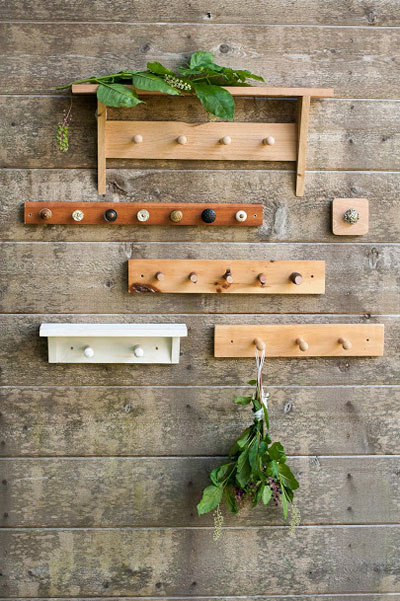
|
A variety of pegboards can be made from the Shaker pegboard shelf plans.
Photo by Ellen Blackmar
|
Andrea Ramsay is a dedicated student of hand tool woodworking since attending Port Townsend School of Woodworking and completing their three month intensive program. She left the technology world in 2014 and is happy every day that she traded in her laptop for a chisel. She does commissioned work out of her shop in Seattle's Equinox Studios.
Andrea can be reached directly via email at
andrearamsay@gmail.com
and you can check out her website at
www.andrearamsay.com
and follow her on Instagram at
@andrearrr
.
Return to
Wood News
front page


